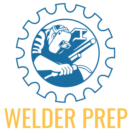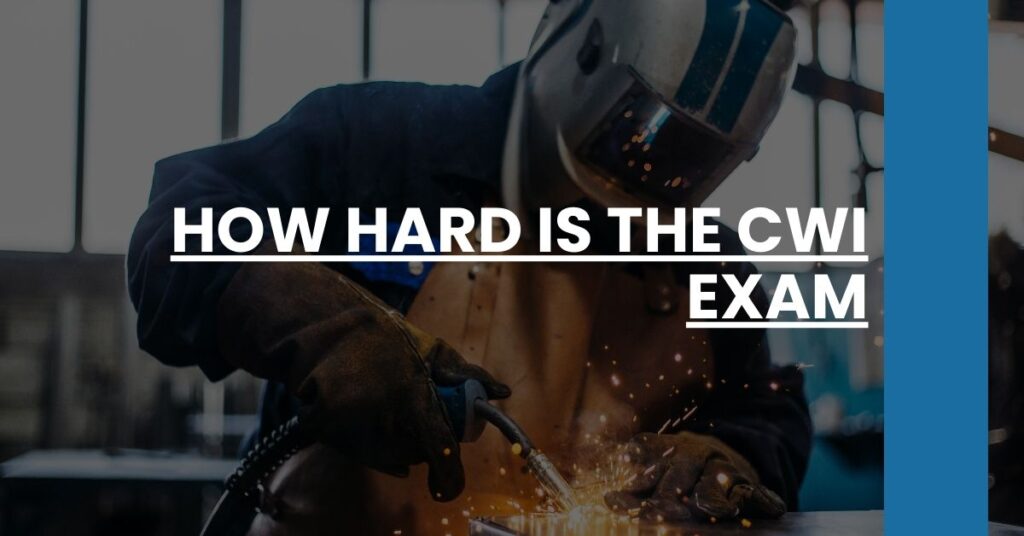The CWI exam is notoriously challenging. It includes three parts: fundamentals, practical, and codebook navigation. Each section demands deep theoretical knowledge, hands-on skills, and precision in interpreting complex codes.
To pass, you’ll need:
- Extensive study
- Practical experience with inspection tools
- Effective time management skills
Ready to tackle it? Here’s how you can succeed.
- Understanding the CWI Exam
- Difficulty Level of the CWI Exam
- Exam Preparation: What to Expect
- Common Challenges Faced by Candidates
- Strategies for Success
- Importance of Practical Experience
- Available Resources for CWI Exam Preparation
- Testimonials from Successful CWIs
- Conclusion: Is the CWI Exam Really That Hard?
Understanding the CWI Exam
The Certified Welding Inspector (CWI) exam, administered by the American Welding Society (AWS), is a credential that demonstrates your expertise in welding inspection, procedures, and safety standards. This certification is crucial for maintaining high-quality welding practices, ensuring structural integrity, and enhancing workplace safety across various industries such as construction, manufacturing, and aerospace.
Purpose and Importance of the CWI Certification
Achieving CWI certification signifies that you possess the skills and knowledge required to uphold welding standards. Industries rely on CWIs to ensure that welding work meets the necessary quality and safety regulations. This certification often leads to career advancement opportunities and higher earning potential.
Exam Structure Breakdown
The CWI exam consists of three distinct parts:
- Part A: Fundamentals:
- This section tests your theoretical knowledge of welding. You’ll encounter multiple-choice questions covering welding processes, heat and temperature control, metallurgy, weld metal characteristics, and welding safety standards.
- Part B: Practical:
- The practical examination evaluates your ability to identify welding discontinuities using inspection tools such as micrometers, calipers, and weld gauges. It requires a solid understanding of weld quality and inspection techniques.
- Part C: Codebook:
- This part assesses your proficiency in navigating and interpreting welding codes. You’ll use a specific codebook, such as the AWS D1.1, to answer questions related to welding procedures and standards.
Difficulty Level of the CWI Exam
The CWI exam’s difficulty stems from its rigorous and thorough examination of both theory and practice. Here’s a deeper exploration of why it’s considered challenging:
Breadth of Knowledge Required
You need to have a well-rounded understanding of various welding disciplines. This includes:
- Metallurgy: Knowing the properties and behaviors of different metals under various conditions.
- Welding Processes: Understanding different welding techniques and applications.
- Defect Identification: Being able to recognize and categorize various types of weld defects.
- Safety Protocols: Adhering to safety regulations and protocols during welding operations.
Practical Skills Demanded
The practical portion of the exam requires proficiency with multiple inspection tools and techniques. You must be able to identify welding discontinuities accurately and understand their implications on weld quality. This hands-on component can be particularly challenging for those who lack substantial field experience.
Code Interpretation
The codebook segment tests your ability to interpret and apply complex welding codes. It’s not enough to understand welding procedures; you must also be adept at quickly locating and correctly interpreting sections within the codebook. Time management and codebook navigation skills are crucial here.
Psychological Pressure
The high stakes associated with the exam add psychological pressure. The reputation of the CWI qualification process and the significant career impact it carries can cause stress and anxiety, potentially affecting your performance if not managed properly.
Exam Preparation: What to Expect
To prepare effectively for the CWI exam, you need a strategic blend of theoretical study and practical experience.
Recommended Study Materials
Several key resources can aid your study efforts:
- AWS Standard Publications: These include the AWS B5.1 and QC1 standards, which outline the essential knowledge and skills for CWIs.
- Welding Inspection Technology Workbook: This helps in understanding the theoretical aspects you will encounter in the exam.
- AWS Welding Handbook: A comprehensive guide covering various welding topics in detail.
Courses and Training
Enrolling in preparatory courses offers structured learning and hands-on training opportunities. These courses, offered by AWS and other organizations, typically cover all three parts of the exam and provide practical exercises and mock tests.
Gaining Practical Experience
Practical experience is indispensable. Working under the guidance of experienced CWIs will help you master inspection tools and techniques. It’s also important to gain real-world insights and develop a keen eye for identifying weld defects.
Online Courses and Tools
Many online platforms provide courses on welding fundamentals and CWI exam preparation. These courses can be an excellent supplement to your study plan, offering flexibility to learn at your own pace.
Internal Link for Further Resources
To explore courses and tools that can help you prepare for the CWI exam, visit our CWI Exam Preparation Services.
Common Challenges Faced by Candidates
Preparing for the CWI exam presents several common challenges that you should be aware of:
Time Management
Balancing study time and work can be difficult, especially if you’re working full-time. Creating a structured study schedule and sticking to it is crucial. It’s also important to practice pacing yourself during mock exams to ensure you can complete each section within the given time limits.
Understanding Complex Codes
Interpreting complex codes is one of the most challenging aspects of the exam. You need to become proficient with the specific codebook you’ll be tested on, such as the AWS D1.1. Regular practice and familiarization with the layout and sections of the codebook will be beneficial.
Practical Inspection Skills
Without substantial hands-on experience, the practical part of the exam can be intimidating. It requires meticulous attention to detail and proficiency with various inspection tools. Gaining experience through apprenticeships or under the mentorship of experienced CWIs can significantly improve your practical skills.
Balancing Theory and Practice
Mastering both theoretical knowledge and practical skills requires a balanced approach. You must dedicate equal time to studying theoretical concepts and practicing hands-on inspection techniques. This balanced preparation ensures you’re well-rounded and ready for all parts of the exam.
Psychological Stress
The pressure of the CWI exam, combined with its reputed difficulty, can cause stress and anxiety. It’s crucial to adopt stress-management techniques such as breaks, physical exercise, and mindfulness practices to maintain a clear and focused mind during preparation.
By understanding these challenges and addressing them with a structured and strategic approach, you can significantly improve your chances of passing the CWI exam and achieving this prestigious certification.
Strategies for Success
Develop a Robust Study Plan
Having a detailed study plan is crucial for successfully preparing for the CWI exam. Here are a few tips to shape your study plan:
- Break down the syllabus: Understand which topics are covered in each part of the exam. Allocate specific time blocks to individual subjects.
- Set realistic goals: Set attainable, measurable objectives for your study sessions, enabling you to track your progress and stay motivated.
- Utilize varied resources: In addition to textbooks, incorporate online courses, instructional videos, and study groups to enrich your learning experience.
Master the Fundamentals
To excel in the fundamentals section (Part A), ensure you have a firm grasp of the theoretical aspects of welding:
- Understand key concepts: Focus on critical aspects like welding processes, heat control, and metallurgy.
- Regular review: Periodically revisit critical topics to reinforce your understanding.
- Practice questions: Use sample tests and previous exam questions to familiarize yourself with the exam format.
Gain Practical Experience
For Part B, the practical portion, immerse yourself in hands-on welding inspection:
- Work on real inspections: Collaborate with experienced CWIs to gain practical insights and enhance your inspection skills.
- Tool proficiency: Become adept at using essential inspection tools like micrometers and calipers.
- Mock testing: Simulate practical exams to build confidence and identify areas needing improvement.
Navigate the Codebook Efficiently
Part C assesses your ability to navigate and interpret welding codes:
- Know your codebook: Spend time familiarizing yourself with the layout and sections of the specified codebook, such as AWSD1.1.
- Practice lookups: Regularly practice locating specific codes and interpreting their requirements swiftly.
- Time management: Develop strategies to manage your time efficiently during this section of the exam.
Leverage Practice Tests
Practice exams are invaluable tools for CWI exam preparation:
- Gain confidence: Familiarize yourself with the question formats and timing through regular practice tests.
- Identify weaknesses: Use practice test results to pinpoint weak areas that need more focus.
- Simulate exam conditions: Practice under conditions similar to those of the actual exam to build endurance and reduce test anxiety.
Importance of Practical Experience
The practical skills component of the CWI exam often intimidates candidates due to its hands-on nature.
Emphasize Hands-On Learning
To improve your chances, dedicate time to practical learning:
- Inspect real welds: Work on actual welding projects, inspect the welds, and collaborate with experienced inspectors.
- Use the tools: Gain familiarity with inspection tools, ensuring you can use them accurately under exam conditions.
Translate Theory into Practice
Welding inspection isn’t just about spotting defects; it’s about understanding why they occur:
- Analyze defects: Study different types of defects and their causes to enhance your inspection capabilities.
- Apply knowledge: Apply theoretical knowledge to real-world scenarios to solidify your understanding.
Build a Practical Toolkit
Develop a personal toolkit of best practices and techniques:
- Keep updated: Stay current with the latest inspection techniques and tools.
- Record learnings: Maintain a journal of practical experiences, detailing techniques and tools that have proven effective.
Available Resources for CWI Exam Preparation
Books and Publications
Several authoritative books can guide you through the CWI exam preparation process:
- AWS Welding Handbook: A comprehensive guide covering all aspects of welding.
- CWI Study Guide: Specific guides tailored to the CWI exam content and format.
- Welding Inspection Technology Workbook: This workbook complements theoretical learning with practical exercises.
Online Courses and Tutorials
Utilize online platforms for flexible, self-paced learning:
- AWS Online Training: Offers a range of courses specifically designed for CWI exam preparation.
- Coursera and Udemy: Platforms providing specialized welding and inspection courses.
- Interactive tutorials: Engage in online tutorials that allow hands-on learning and practice.
Practice Tests and Workshops
Engaging in practice tests and workshops can significantly enhance your readiness:
- AWS Practice Exams: Official practice exams provide a realistic preview of the actual test.
- Study workshops: Attend workshops and seminars to gain expert insights and peer support.
For more information on available resources and services to aid your CWI exam preparation, visit our CWI Exam Services.
Testimonials from Successful CWIs
Insights from Mark T., CWI
“Consistent study and hands-on practice were key to my success. The CWI exam is tough, but with the right preparation, it’s definitely achievable.”
Advice from Sarah L., CWI
“I relied heavily on the AWS study guides and attended a preparatory course that made all the difference. Don’t underestimate the practical part; get as much hands-on experience as possible.”
Experiences from John D., CWI
“Balancing study with practical work helped me understand the material better. Joining a study group can also provide support and motivation.”
Conclusion: Is the CWI Exam Really That Hard?
While the CWI exam presents various challenges, strategic preparation and dedication can lead to success. Aspiring CWIs need to focus on building a strong theoretical foundation, acquiring substantial practical experience, and employing effective study techniques. With these steps, achieving the prestigious CWI certification becomes a realistic and rewarding goal, opening doors to advanced career opportunities in the welding industry.

